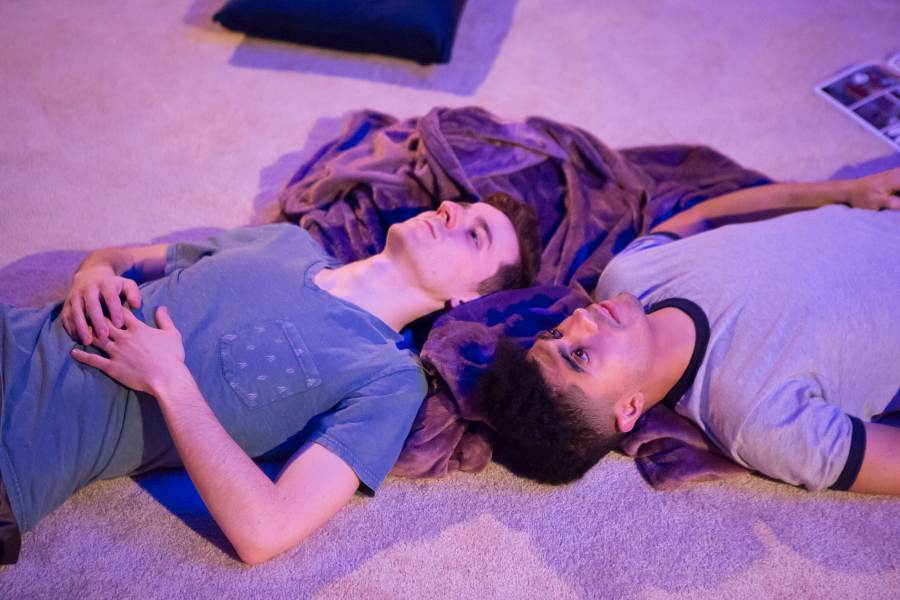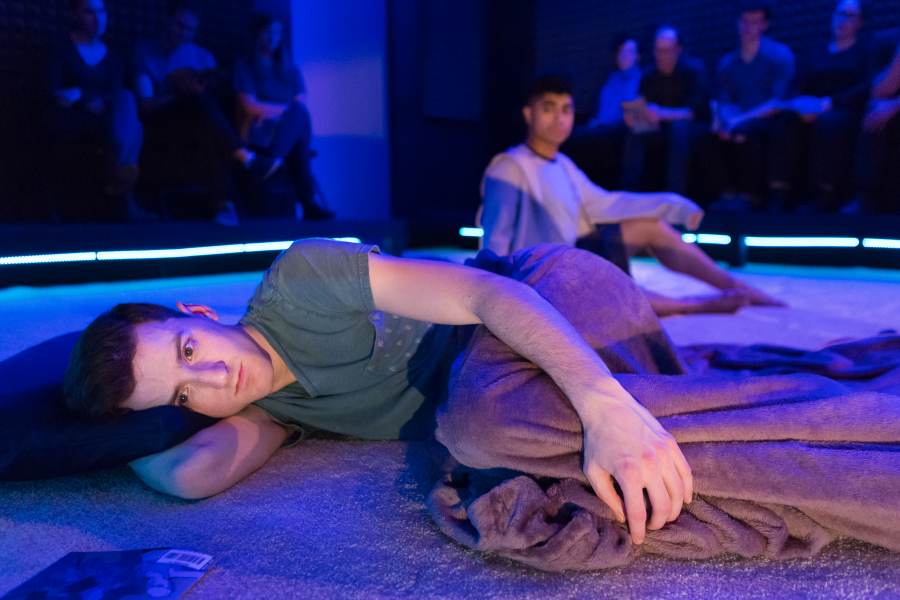

Besides being a playwright, Mease is also a prop designer, and you can tell how his eye for design comes into play in Omega Kids, even though there are very few props in the show, everything feels lived in and specific. Things that in other shows might go unnoticed, like the white carpet that covers the stage in this one for example, become something magical. It’s on this innocuous white carpet that we see the “prints” left behind by the Michaels as they engage in their flirty dance, the marks on the carpet almost become traces of the origins of love. I spoke to the playwright about the inspiration behind Omega Kids, designing the comic book that compliments the show, and why objects are so important to him.
You’re a prop designer and a playwright. So what was the egg/chicken situation with Omega Kids, did the comic book come before the play, or was it the other way around?
They both came at the same time. I moved to New York to be a playwright, I fell into prop designing as a way to get into the room with all these great artists, I wanted to see how they put a play together. It’s hard to nail down where this one started, but one of them was a feeling that a lot of conversations I’d been having with friends were summaries of other stories, we’d tell each other what TV shows we were watching, and that was sort of the medium for how we learned new things about each other. So I decided to write a play where this happened through comics, while thinking about the importance of objects and how important this comic would be in the play, I realized “I’m gonna have to make it”.
The comic book has an ad in the back saying that a DVD will come out in 2007, was this the year you started working on it?
No, the significance of 2007 is basically that one of the X-Men comics that most influenced this one came out that year.
Cool, so that means the character Red Lightning in your comic book might be inspired by Phoenix?
A little bit yeah. This play is about superheroes but also about how it feels like to stay up with someone new at the beginning of a relationship, I think that when this happens you feel like you have superpowers. I was thinking about where superpowers come from, sometimes it’s alien exposure, sometimes an external force enters your body.
Can we talk about the set design? The stage reminded me of a sandbox, it’s so playful and intimate.
It’s a really cool space we created, I knew this play was about sitting on the floor, about the feeling of rolling around on a carpet, to create a soft, mundane void where anything can happen. I learned while working in Small Mouth Sounds that if you wanna stage anything on the floor, you need to put the audience above, so we started from that concept. We wanted the set to let you see the story and also feel protected, kind of like a 2001: A Space Odyssey feeling.
I loved the lines “then, like, when you meet someone who just fits in a book or something, the story, the whole universe just creates a place for them to exist”. It made me wonder if the reason why you wanted to write plays is to create perfect moments you can’t control in real life?
The sort of tragedy of the play is that the characters don’t know they could be doing theatre. That scene and that line are so important because we grow up learning about stories that you experience as an outsider and they unfold as they should, but when they happen to you in real life they feel like everything will fall apart at any moment. You need to be brave, superheroes are brave because they fight villains, but we need to be brave by taking ownership of our lives. I’ve always liked stories about superheroes coming together to save the world, and that’s what theatre feels like. As a part of design teams it’s like we each have our own superpower, but we’re all trying to tell the same story. Sometimes the lighting designer can’t tell a part of the story with light, so they’ll ask the sound designer for help. As a team there’s nothing like tech week to feel like you’ve been to the end of the world and back.

I was surprised to see that it was also a queer love story! I was moved beyond words most of the time.
It works for me too (laughs), I think people are drawn into the play by the comic book and then realize it’s also a queer love story. Even though the characters don’t necessarily identify as gay, and might feel they’re underserved by the labels available. To watch two male bodies create their own relationship, dynamic and sexuality and how it’s both exciting and terrifying is what I hope the play is doing.
It was also especially exciting to see how you’re combining worlds that are usually kept separate. I’m far from a comic book person, and I was so drawn into this world.
Jay Stull, our director, wasn’t a comic book guy at all either, a lot of people who have come to the show or will come to the show, probably comics aren’t the draw for them. It’s great to realize the play is specific to the queer experience, but also older straight men who have seen it have said they identify with staying up all night with comic books.
You also worked on two of the shows I’ve liked the most recently, Natasha, Pierre and the Great Comet of 1812 and The Light Years. Did working on the props for those two shows in any way inform Omega Kids?
Definitely, The Debate Society was actually the first company to hire me to do props. I had an internship that ended and I needed to find a way to stay in New York, so I offered to be their intern, they said they didn’t need one, but they needed a prop designer, so I started making props. I love working with them, when you start doing a show with them Hannah Bos’ mom sends you a box with awesome objects from her prop shop in Illinois. I feel so greatly influenced by them, they taught me how to think of theatre through objects, not necessarily through writing. I’ve worked with Rachel Chavkin on several occasions and seeing the way she uses space was especially important for Omega Kids. Just seeing what they’re doing at the Imperial Theater, it’s a whole experience, you start thinking about the play from the moment you enter the theater. That consideration of the whole night, rather than just the show, led us to the cube we designed for our play. You see the cube and all the noise of New York goes away.
For more information and tickets to Omega Kids click here.